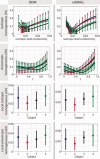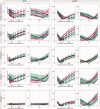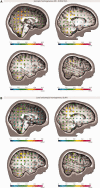Modeling of the human skull in EEG source analysis
- PMID: 20690140
- PMCID: PMC6869856
- DOI: 10.1002/hbm.21114
Modeling of the human skull in EEG source analysis
Abstract
We used computer simulations to investigate finite element models of the layered structure of the human skull in EEG source analysis. Local models, where each skull location was modeled differently, and global models, where the skull was assumed to be homogeneous, were compared to a reference model, in which spongy and compact bone were explicitly accounted for. In both cases, isotropic and anisotropic conductivity assumptions were taken into account. We considered sources in the entire brain and determined errors both in the forward calculation and the reconstructed dipole position. Our results show that accounting for the local variations over the skull surface is important, whereas assuming isotropic or anisotropic skull conductivity has little influence. Moreover, we showed that, if using an isotropic and homogeneous skull model, the ratio between skin/brain and skull conductivities should be considerably lower than the commonly used 80:1. For skull modeling, we recommend (1) Local models: if compact and spongy bone can be identified with sufficient accuracy (e.g., from MRI) and their conductivities can be assumed to be known (e.g., from measurements), one should model these explicitly by assigning each voxel to one of the two conductivities, (2) Global models: if the conditions of (1) are not met, one should model the skull as either homogeneous and isotropic, but with considerably higher skull conductivity than the usual 0.0042 S/m, or as homogeneous and anisotropic, but with higher radial skull conductivity than the usual 0.0042 S/m and a considerably lower radial:tangential conductivity anisotropy than the usual 1:10.
Copyright © 2010 Wiley-Liss, Inc.
Figures






Similar articles
-
Dipole estimation errors due to not incorporating anisotropic conductivities in realistic head models for EEG source analysis.Phys Med Biol. 2009 Oct 21;54(20):6079-93. doi: 10.1088/0031-9155/54/20/004. Epub 2009 Sep 24. Phys Med Biol. 2009. PMID: 19779215
-
Influence of anisotropic electrical conductivity in white matter tissue on the EEG/MEG forward and inverse solution. A high-resolution whole head simulation study.Neuroimage. 2010 May 15;51(1):145-63. doi: 10.1016/j.neuroimage.2010.02.014. Epub 2010 Feb 13. Neuroimage. 2010. PMID: 20156576
-
Modeling skull electrical properties.Ann Biomed Eng. 2007 Oct;35(10):1699-712. doi: 10.1007/s10439-007-9343-5. Epub 2007 Jul 14. Ann Biomed Eng. 2007. PMID: 17629793 Free PMC article.
-
Variation in Reported Human Head Tissue Electrical Conductivity Values.Brain Topogr. 2019 Sep;32(5):825-858. doi: 10.1007/s10548-019-00710-2. Epub 2019 May 3. Brain Topogr. 2019. PMID: 31054104 Free PMC article.
-
Development of volume conductor and source models to localize epileptic foci.J Clin Neurophysiol. 2007 Apr;24(2):101-19. doi: 10.1097/WNP.0b013e318038fb3e. J Clin Neurophysiol. 2007. PMID: 17414966 Review.
Cited by
-
Finite-Element Model Predicts Current Density Distribution for Clinical Applications of tDCS and tACS.Front Psychiatry. 2012 Sep 24;3:83. doi: 10.3389/fpsyt.2012.00083. eCollection 2012. Front Psychiatry. 2012. PMID: 23015792 Free PMC article.
-
Numerical Simulation of Concussive-Generated Cortical Spreading Depolarization to Optimize DC-EEG Electrode Spacing for Noninvasive Visual Detection.Neurocrit Care. 2022 Jun;37(Suppl 1):67-82. doi: 10.1007/s12028-021-01430-x. Epub 2022 Mar 1. Neurocrit Care. 2022. PMID: 35233716 Free PMC article.
-
Combined EEG/MEG can outperform single modality EEG or MEG source reconstruction in presurgical epilepsy diagnosis.PLoS One. 2015 Mar 11;10(3):e0118753. doi: 10.1371/journal.pone.0118753. eCollection 2015. PLoS One. 2015. PMID: 25761059 Free PMC article.
-
Using transcranial direct-current stimulation (tDCS) to understand cognitive processing.Atten Percept Psychophys. 2017 Jan;79(1):3-23. doi: 10.3758/s13414-016-1224-2. Atten Percept Psychophys. 2017. PMID: 27804033 Free PMC article. Review.
-
Memory quality modulates the effect of aging on memory consolidation during sleep: Reduced maintenance but intact gain.Neuroimage. 2020 Apr 1;209:116490. doi: 10.1016/j.neuroimage.2019.116490. Epub 2019 Dec 25. Neuroimage. 2020. PMID: 31883456 Free PMC article.
References
-
- Akhtari M, Bryant HC, Marnelak AN, Flynn ER, Heller L, Shih JJ, Mandelkern M, Matlachov A, Ranken DM, Best ED, DiMauro MA, Lee RR, Sutherling WW ( 2002): Conductivities of three‐layer live human skull. Brain Topography 14: 151–167. - PubMed
-
- Awada KA, Jackson DR, Williams JT, Wilton DR, Baumann SB, Papanicolaou AC ( 1997): Computational aspects of finite element modeling in EEG source localization. IEEE Trans Biomed Eng 44: 736–752. - PubMed
-
- Baysal U, Haueisen J ( 2004): Use of a priori information in estimating tissue resistivities—Application to human data in vivo. Physiol Meas 25: 737–748. - PubMed
-
- Bertrand O (1991): 3D Finite element method in brain electrical activity studies. In Nenonen J, Rajala HM, Katila T. (Eds.) (1991): Biomegnetic localization and 3D Modeling, pp. 154–171, Helsinki University of Technology, Helsinki, Finnland.
-
- Braess D (2007): Finite Elements: Theory, Fast Solvers, and Applications in Solid Mechanics, Cambridge University Press; 3 edition (April 30, 2007), ISBN‐10: 0521705185, ISBN‐13: 978‐0521705189.
Publication types
MeSH terms
LinkOut - more resources
Full Text Sources
Miscellaneous

